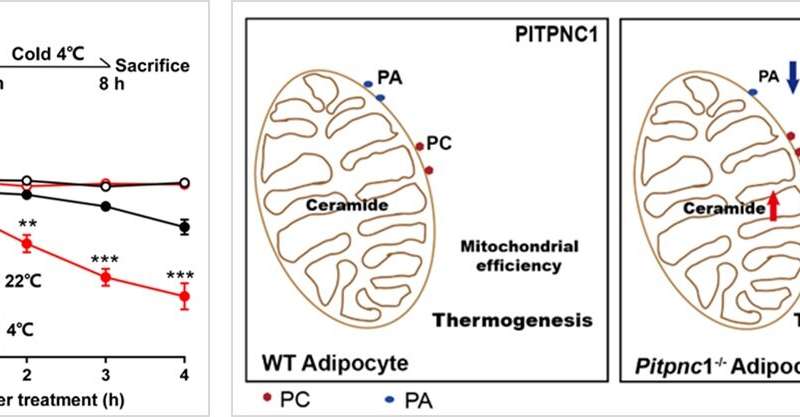Phospholipid transporter PITPNC1 regulates heat production of brown adipocytes

This study was led by Dr. Feng-Jung Chen (Shanghai Key Laboratory of Metabolic Remodeling and Health, Institute of Metabolism and Integrative Biology, Fudan University) and Dr. Peng Li (Shanghai Key Laboratory of Metabolic Remodeling and Health, Institute of Metabolism and Integrative Biology, Fudan University and State Key Laboratory of Membrane Biology and Tsinghua-Peking Center for Life Sciences, Beijing Advanced Innovation Center for Structural Biology, School of Life Sciences, Tsinghua University).
Dr. Feng-Jung Chen, Dr. Guoqing Tang, and collaborators worked to identify the physiological significance of phosphatidylinositol transfer protein, cytoplasmic 1 (PITPNC1), which is a phospholipid transporter and reciprocally transfers phospholipids between intracellular membrane structures.
The team of scientists found that PITPNC1 is mainly expressed in metabolic tissues. They thus generated Pitpnc1 whole-body knockout (Pitpnc1-/-) mice using CRISPER-Cas9 technique to examine the physiological role of PITPNC1. However, with a series of metabolic measurements when mice were subjected to normal or high-fat diet treatment for 16-weeks, they concluded that PITPNC1 deficiency does not play a role in the development of obesity.
Next, the team examined PITPNC1's role in thermogenesis by subjecting the mice to acute cold exposure. They found that Pitpnc1-/- mice developed hypothermia. Their results indicate that PITPNC1 is required for body temperature maintenance of mice under acute cold exposure.
Further biochemical tests found that compared with wildtype mice, the serum glucose in Pitpnc1-/- mice was significantly decreased and the fat storage in brown adipose tissue (BAT) remained, which indicate that Pitpnc1-/- mice normally used serum glucose for heat production, and imply that Pitpnc1 gene deletion led to the decline of fat consumption and thermogenesis of the BAT using fatty acids. It reveals the physiological role of Pitpnc1 gene in maintaining the body temperature of mice under acute cold exposure.
In order to reveal the pathological mechanism of hypothermia in Pitpnc1-/- mice, the research team further detected four key steps of lipid metabolic function in brown adipocytes: lipid uptake, lipid accumulation, lipolysis, and β-oxidation of free fatty acids, etc. The results revealed that compared with wildtype brown adipocytes, Pitpnc1-/- brown adipocytes showed no difference in the expression and membrane localization of CD36, the accumulation of lipid droplets after oleic acid treatment, and the release of fatty acids and glycerol after isoproterenol treatment. But, Pitpnc1-/- brown adipocytes showed a significantly reduced oxygen consumption rate. The measurement of oxygen consumption rate of purified mitochondria further confirmed this result. In order to further explore the cause of mitochondrial dysfunction in Pitpnc1-/- brown adipocytes, the lipidomics of purified mitochondria showed that loss of PITPNC1 proteins would lead to excessive accumulation of phosphatidylcholine (PC), sphingomyelin (SM), and ceramides in mitochondria, but there was no significant change in key proteins on mitochondria (such as CPT1, COX4, etc.). It has been reported that excessive accumulation of ceramides in mitochondria will limit mitochondrial β-oxidation. These results show that the loss of PITPNC1 proteins causes the disorder of mitochondrial phospholipids probably due to the defect of phospholipid transport between organelles, and ultimately leads to the defect of mitochondrial thermogenesis in brown adipocytes (see below, right image).
To sum up, the research team revealed for the first time the physiological significance of PITPNC1 in maintaining the body temperature of mice under acute cold exposure. This discovery provides insights into the theoretical significance of lipid trafficking in the regulation of thermogenesis by the body. Furthermore, Pitpnc1 gene is expected to be used as a target to develop new strategies to prevent and treat metabolic diseases such as obesity.
See the article:
PITPNC1 promotes the thermogenesis of brown adipose tissue under acute cold exposure
https://doi.org/10.1007/s11427-022-2157-y
More information:
Guoqing Tang et al, PITPNC1 promotes the thermogenesis of brown adipose tissue under acute cold exposure, Science China Life Sciences (2022). DOI: 10.1007/s11427-022-2157-y
Provided by Science China Press